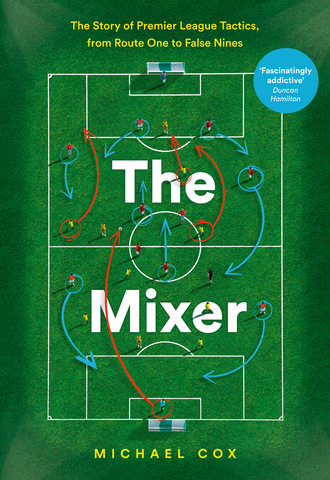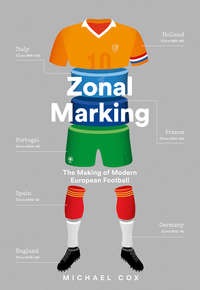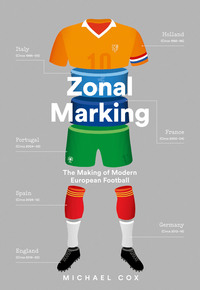
Полная версия
The Mixer: The Story of Premier League Tactics, from Route One to False Nines
His unveiling was a huge event in Middlesbrough. Fans greeted him at the airport with Brazilian flags, more cheered as he arrived at the new Riverside Stadium in scenes reminiscent of a papal visit, then 6,000 moved inside to watch him play keepy-uppies with Robson. His first press conference didn’t pass without one inevitable question. ‘Does he know how cold it gets in Middlesbrough in January?’ asked one journalist. Juninho, through a translator, insisted it wouldn’t be that bad, although he was often criticised by pundits for playing in gloves, and during his first winter stuffed newspaper inside his boots in an attempt to keep his feet warm. Robson responded by describing Juninho as a ‘tough character’ – and most top-class Brazilian attackers are. The cliché about Brazil suggests it’s non-stop samba football, played by technical players who learn their trade playing on the Copacabana. Realistically, the Brazilian top flight is extremely aggressive: it’s not simply that defenders kick attackers ferociously, it’s that referees allow it, and so Juninho’s transition from Brazilian to English football wasn’t as tough as many anticipated.
Immediately afforded a free role by Robson, Juninho used that licence fully on his debut against Leeds, starting on the right flank before quickly drifting across to the left. He played two killer through-balls inside the first half, setting up Jan Åge Fjørtoft for the opener. Inevitably, Leeds’s response was to kick him, and both Carlton Palmer and John Pemberton were booked for fouling the Brazilian. The Independent’s match report remarked upon his ‘surprising courage’ and ended with an acknowledgement that ‘perhaps he is tougher than anyone thought.’ Indeed, his final significant contribution before being substituted was a thundering tackle on legendary crossbar-botherer Tony Yeboah, one of the Premier League’s most powerful players, which earned a booking. That went down well, as fans wanted proof he would get stuck in.
A fresh-faced, slender creator whose name meant ‘Little Junior’ – so small they named him twice – the Brazilian wasn’t expected to thrive in English conditions, but Juninho loved the north-east and loved English football. The club found him a house in Ingleby Barwick, a large housing estate, and he moved in with his entire family, which helped him settle. Juninho’s house became something of a local landmark, with children queuing outside for his autograph. His mum made them cookies, and Juninho wasn’t averse to the occasional kickabout in the street.
Juninho was tricky but direct in possession, efficient with the ball rather than a showboater. He was an instant hit, and unquestionably in the class of the aforementioned number 10s, later playing a significant role in Brazil’s 2002 World Cup triumph. In Juninho’s second season, Alex Ferguson described him as the Premier League’s best player and later considered signing him. His finest moment in English football arrived during that campaign, a 1–0 home victory over Chelsea in March. He outshone Zola and created a succession of chances, wasted by Craig Hignett and Mikkel Beck. Eventually, he settled things himself. Receiving the ball wide on the left, he slalomed between Wise and Di Matteo and evaded a desperate lunge from Chelsea’s third central midfielder, Craig Burley, before slipping the ball into the left-hand channel for Beck. The Danish striker paused, and then chipped the ball into the box for a perfect diving header from – of all people – five-foot-six Juninho. The Brazilian magician wasn’t simply performing the duties expected of a Brazilian number 10, outwitting the entire opposition midfield, but also the duties of an English number 9, beating Chelsea’s centre-backs to score a header. ‘I don’t know what Juninho’s running on at the moment,’ Robson said afterwards. ‘He isn’t looking tired, he’s keeping pace with the game – and he’s tackling back!’ Make that the qualities of an English number 4, too.
In his second season Juninho was handed Middlesbrough’s number 10 shirt, having worn 25 in his debut campaign, and was also named the Premier League’s Player of the Season. Admittedly not as prestigious an award as the PFA or FWA Player of the Year, it was nevertheless an acknowledgement of his great influence. And yet, staggeringly for one of the league’s most revered players, Juninho ended the campaign sobbing on the pitch as Middlesbrough were relegated.
Basing the side around Juninho didn’t pay dividends. When Juninho made his debut for Middlesbrough in November 1995, the Teesiders were sixth, having lost to only the two title challengers, Manchester United and Newcastle. Despite Juninho’s impact, their form nosedived dramatically. They were atrocious in the second half of the season, winning just two of 19 matches. They finished 12th, but in points terms, were closer to relegation than 11th.
The 1996/97 relegation campaign was also strange for Middlesbrough. They reached both the League Cup and FA Cup finals, losing to Leicester City and Chelsea respectively – a devastating double blow for a club that had never won a major honour (although Juninho would later help them to League Cup success seven years later, then into his third spell on Teeside – he simply couldn’t stay away). Granted, Middlesbrough’s relegation was partly because they were deducted three points for withdrawing from a December fixture at Blackburn when half their squad had been wiped out by flu, but you can’t ignore the fact that they had the division’s worst defensive record. There were also major problems in the dressing room, particularly involving star striker Fabrizio Ravanelli, a divisive influence. He once interrupted a team meeting with a lengthy rant in Italian about wanting to leave, and had a fight with Neil Cox before the FA Cup Final after the right-back suggested Ravanelli wasn’t fit enough to start. ‘Half the squad hated him and the other half loved him,’ said Hignett. ‘He was one of the best finishers I’ve seen, but he rubbed people up the wrong way. He was selfish in everything he did.’
Meanwhile Juninho, while individually brilliant and very popular with teammates, caused Middlesbrough problems. Like Cantona, Bergkamp and Zola, he thrived in space between the lines, but was a different type of footballer. An advanced midfielder rather than a withdrawn forward, he ventured into deeper positions to collect possession. He therefore wasn’t suited to a deep-lying forward role in a 4–4–1–1 like the aforementioned players, and Robson constantly changed his shape in an attempt to base the side around both Juninho and Barmby, deploying 4–3–2–1 or 3–4–2–1 in his first season. It didn’t quite work defensively, and getting the best from two players between the lines was difficult. Both Juninho and Barmby had a better relationship with the underrated Hignett, and Barmby departed after 18 months for Everton, leaving Juninho as the sole creator. His form improved, and a 6–1 thrashing of Derby demonstrated Middlesbrough’s potential. ‘I am now playing as well as I ever did in Brazil, but I think that is because I have found my best position,’ Juninho said. In other words, the system was based around him.
In that second season Juninho suffered from fatigue, not helped by Middlesbrough’s double cup run – or by international trips to South America, then an unprecedented problem for Premier League clubs. His biggest problem, though, was man-marking – Middlesbrough didn’t have a Plan B when Juninho was nullified. The most famous example came during the 1997 League Cup Final defeat to Leicester. Two weeks beforehand in the league, Juninho had torn apart the Foxes in a 3–1 victory, so for the trip to Wembley, Leicester boss Martin O’Neill deployed Pontus Kåmark to follow the Brazilian everywhere across the pitch. In a 2011 interview discussing nearly 25 years in management, O’Neill said he’d never sent his teams out to be anything other than positive – apart from that final, when he knew he needed to concentrate on stopping Juninho. ‘If you had seen him a fortnight before running riot at Filbert Street, only a fool would have chosen not to man-mark him,’ he said. Many other managers thought the same; stop Juninho, and you stopped Middlesbrough. Ultimately, it ended with their relegation.
This became a familiar pattern among bottom-half clubs – brilliant individuals who weren’t necessarily conducive to Premier League success. Bolton spent a club record £1.5m on Yugoslav playmaker Saša Ćurčić, who scored one of the goals of 1995/96 against Chelsea, ghosting past five challenges and playing a one-two with Alan Thompson before firing home. Bolton finished bottom that season. ‘I was a crowd pleaser, everywhere the fans loved me,’ Ćurčić recalled. ‘But I wasn’t very good for the team because I wasn’t a team player.’
Another inventive playmaker who scored a memorable solo goal that season was Manchester City’s Georgi Kinkladze – the epitome of a frustrating genius – who demonstrated the dangers of building your side around a number 10. Like Juninho, Kinkladze was recruited after a sensational performance against British opposition, at a time when Premier League scouts rarely looked abroad for new players. Kinkladze was inspirational in Georgia’s 5–0 thrashing of Wales in November 1994, a seismic result; just three years after Georgia had gained independence, it was their first-ever competitive victory. Deployed behind Temuri Ketsbaia and Shota Arveladze in a 4–3–1–2, Kinkladze ran the game and grabbed his first international goal. ‘They murdered us,’ Wales goalkeeper Neville Southall later recalled. ‘Kinkladze was different class and the best player on the pitch by a mile.’ In the return fixture the following summer – four days before Juninho’s performance at Wembley captured Middlesbrough’s attention – Kinkladze again dominated. This time he scored the game’s only goal, an incredible 25-yard, left-footed chip over Southall.
The Georgian was tracked by other clubs, and had unsuccessful trials at both Real and Atlético Madrid – and, intriguingly, a month-long loan at Boca Juniors, who revere the number 10 role more than any club in world football, where Kinakladze met his idol Maradona. None of them signed Kinkladze permanently, however, and instead he joined Manchester City as Alan Ball’s first signing. Ball and Kinkladze’s City experience started disastrously. City collected two points from their first 11 games, scoring just three goals, while Kinkladze struggled; homesick, unable to speak English and living in a Manchester hotel on his own for three months. Juninho was happy in Middlesbrough partly because he’d emigrated with his parents, and Kinkladze’s improvement coincided with the arrival of two Georgian friends and his mother, Khatuna, who brought some home comforts: Georgian cognac and walnuts, and spices to make Kinkladze his favourite dishes.
Kinkladze scored his first goal in November, a late winner in the 1–0 victory over Aston Villa at Maine Road. ‘He was bewildered to start with,’ Ball said afterwards. ‘He spoke very little English and it was foreign to him to tackle and scrap and fight like you do in England. But the boy’s got an immense talent.’ His Premier League spell is best remembered for a couple of truly magnificent goals. The first opened the scoring against Middlesbrough in December 1995, when he collected the ball on the right and dribbled into an inside-left position, before suddenly cutting back inside Phil Stamp and sidefooting the ball firmly into the far corner. Middlesbrough eventually won 4–1, however, with Juninho completing the scoring.
Kinkladze’s other superb strike, later voted March’s goal of the month, came at Southampton. Having already scored the first with a close-range tap-in, and hit the crossbar from outside the box, Kinkladze collected the ball on the right, dribbled directly towards goal while evading four increasingly desperate challenges, dummied to put goalkeeper Dave Beasant on the ground, then lifted the ball over Beasant’s head and into the net. ‘It was the closest thing I have seen to Maradona’s goal against England!’ Ball raved, before somewhat unnecessarily clarifying: ‘Not the one with his hand, the one where he did everyone and put it away. People ask why we are bringing this type of player to this country. If that wasn’t the answer today, nothing is.’
City supporters were already tired of United’s dominance and Cantona’s cult-like status, and they absolutely worshipped Kinkladze – the best Georgi in Manchester since Best. The love was reciprocated; after his initial alienation in Manchester, Kinkladze grew to love the city and married a Mancunian. ‘If he’d been playing with a successful team,’ said striker Niall Quinn at the time, ‘then he would have won Player’s Player of the Year because it’s quite breathtaking what he’s done in English football. He’s a lovely guy as well – I think, because he doesn’t speak a word of English – but he seems nice.’
This was at the height of Britpop, and Kinkladze was rewarded for his fine form with a chant to the tune of Oasis’s ‘Wonderwall’. ‘All the runs that Kinky makes are blinding,’ it ran, before ending with a brilliant: ‘And after all … we’ve got Alan Ball.’ The composer of the original song, City fan Noel Gallagher, also offered a wonderful Kinkladze summary. Describing him as ‘either the most frightening thing I’ve ever seen or the best thing I’ve ever seen’, Gallagher predicted Kinkladze would either lead City to the European Cup, or take them down to the Fourth Division. He was nearly right; when Kinkladze left City in 1998, they were in the third tier.
City were relegated because Ball built the entire team around Kinkladze, as winger Nicky Summerbee outlined. ‘Bally loved him. Georgi could do no wrong – I got on very well with him and we weren’t jealous because we could all see how talented he was, but some hated Alan Ball for doing that – except Georgi, because he loved all the praise … the problem with Georgi was that you couldn’t play 4–4–2 because to get the best out of him you wouldn’t want him playing a conventional running midfield game, and if there are two men wide, that leaves only one in midfield. Ball changed formation all the time, a sure sign he didn’t know what he was doing.’
Keith Curle, then City’s captain, later recalled the extent of the free role Ball afforded Kinkladze. ‘I remember losing away to Arsenal that season and one of the goals we conceded came because Georgi hadn’t tracked a runner. The lads were not happy and some said as much to the manager after the game. In reply, he told them that if they were as talented as Georgi, they wouldn’t have to track back either.’
After City’s relegation, Ball lasted just three games before he was replaced by Frank Clark, who tried a similar approach. ‘I wanted to build the team around Kinkladze because that’s the ideal way to get the best out of him. He’s an incredible talent … [but] he certainly didn’t like running if he didn’t have the ball at his feet and I thought there was a certain amount of resentment towards him from some of the squad.’ Like Ball, Clark ended up changing formation to change Kinkladze’s role. He initially played a 4–4–2 with the Georgian as a deep-lying forward, then switched to 4–3–1–2, fielding him behind a strike duo. ‘We tied ourselves up in knots trying to accommodate Kinkladze,’ Clark continued. ‘The [4–3–1–2] system suited Kinkladze perfectly because it gave him great freedom, but it didn’t suit the other players and it didn’t work.’ Incidentally, Kinkladze switched to number 10 after City’s relegation, having previously worn number 7.
Clarke was replaced by Joe Royle, less of a footballing romantic, whose first words to the board about footballing matters were simple: ‘We have to sell Kinkladze.’ He would no longer be indulged. ‘Kinkladze was not a team player, and had a disturbing habit of disappearing for long periods during games,’ Royle said. ‘To the supporters he was the only positive in all that time. To me he was a big negative.’ The Georgian was sold to European giants Ajax, a club who love technical players but play 4–3–3, so manager Jan Wouters had no space for a number 10. ‘I could have been Maradona and he wouldn’t have changed the system to accommodate me,’ he complained. By this point, managers had tired of basing the side around Kinkladze, who needed a manager like Ball.
Chiefly remembered for his high-pitched voice, his red hair, his flat cap and for being the standout player in the 1966 World Cup Final, Ball was also the first footballer in England to wear white boots – the ultimate sign of a flair player – and clearly wanted like-minded footballers in his sides. Before Kinkladze, Ball had also adored England’s truest number 10 during this period, Southampton’s Matt Le Tissier.
Avoiding the hatred that comes with playing for a title challenger, Le Tissier was the most popular player in the country and a regular winner of Goal of the Month competitions. He scored a wide variety of incredible strikes: there was a chip-up-and-volley from a free-kick against Wimbledon and a legendary strike against Newcastle that involved backheeling the ball over his own head, before flicking the ball over two defenders in a row and volleying in. He lobbed Blackburn’s Tim Flowers from 35 yards and chipped Manchester United’s Peter Schmeichel from 25. He had enough natural ability to be an England regular but, fittingly for a man born in Guernsey, was distinctly un-English. His name added to the foreign feel, and in his younger days his father was contacted by France assistant manager Gérard Houllier, a keen fan of players in Cantona’s mould, who unsuccessfully enquired whether Le Tissier had any French relatives.
Ball declared his love for Le Tissier immediately upon arrival at Southampton, with the south-coast club languishing in the relegation zone. In their first training session Ball and assistant manager Lawrie McMenemy pulled ten players onto the training pitch and assembled them in a defensive shape, leaving Le Tissier wondering if he’d be omitted, as had often happened under previous coach Ian Branfoot. Instead, Ball then dragged Le Tissier into the centre of the group and announced to the other ten players, ‘This is the best player you’ve got on your team. Get the ball to him as often as you can, and he’ll win games for you.’ Le Tissier, a humble man, felt slightly uncomfortable being elevated to this status, but it provided an enormous confidence boost and he scored six goals in his first four appearances under Ball.
Just as Ferguson made allowances off the pitch for Cantona, Le Tissier’s free role extended to socialising. On a rest day midway through a pre-season trip to Northern Ireland, Southampton’s squad had planned a round of golf, but Ball suggested they went to a local pub instead. This was a bad move. After Ball retired to the hotel it turned into an all-day drinking session, capped by the players venturing out to a nightclub. They arrived back at 2 am, blind drunk, with training the following morning. Ball was furious, screaming at Beasant, Iain Dowie and Jim Magilton before sending them to bed. He then took Le Tissier aside and told him, ‘Look, our senior players are setting a bad example … but the way you’re playing, you can do what you like!’ Le Tissier, incidentally, was routinely mocked by teammates for his drinking habits. He didn’t drink beer, preferring Malibu and Coke, although this wasn’t because of a revolutionary, forward-thinking diet – he admits consuming sausage and egg McMuffins ahead of training sessions, and fish and chips the evening before a game. Le Tissier wasn’t the fittest or the hardest-working, and recalls an incident later in his career when then-Southampton manager Gordon Strachan shouted from the technical area to a particularly languid Le Tissier, walking back from an attacking move, ‘Matt! Get yourself warmed up, I’m bringing you off!’
‘Those 18 months Ball was there were the best of my career,’ Le Tissier recalled. ‘Ball built the team around me, instead of trying to fit me into the team.’ Despite playing as an attacking midfielder rather than a forward, Le Tissier hit 45 goals in 64 games in all competitions under Ball, many of them spectacular. Southampton avoided relegation at the end of Ball’s first season, and finished in the top half in his second.
Unfortunately, England managers didn’t share Ball’s enthusiasm for Le Tissier. There was still a suspicion of number 10s in his mould, even among managers like Terry Venables and Glenn Hoddle, who appreciated flair players. English football now adored foreign number 10s but didn’t trust its own, and Le Tissier made the familiar complaint of the 1990s number 10: ‘I think maybe England managers weren’t brave enough to change their formation to accommodate me.’ That said, Hoddle – who was Le Tissier’s boyhood hero – used both him and Liverpool’s Steve McManaman behind Alan Shearer in a fluid 3–4–2–1 shape for a 1–0 defeat to Italy in 1997, England’s first-ever World Cup qualifying defeat at Wembley. It was a performance that encapsulated such an enigmatic footballer; Le Tissier was constantly second to loose balls, conceded possession regularly, and his lack of energy was juxtaposed by the constant running of the wonderful Zola, who played the same role for Italy and fired in the only goal when sprinting in advance of his strike partner. Nevertheless, Le Tissier came closest to scoring for England.
‘It is not a gamble [to play Le Tissier] when you feel the game is going to be tight and the door might need to be unlocked,’ said Hoddle afterwards. ‘Le Tissier, with his talent, could do that.’ Nevertheless, he lost faith in his most creative talent – presumably his faith-healer Eileen Drewery hadn’t been able to help – and failed to include Le Tissier in his 30-man provisional 1998 World Cup squad, a blow Le Tissier admits he never recovered from. The ultimate 1990s Premier League player discovered the devastating news in a brilliantly 1990s way: by reading Teletext.
English football had learned to appreciate the quality provided by number 10s, but was still largely fixated on variations on 4–4–2. Therefore, while the entire definition of a number 10 is that he’s neither a forward nor a midfielder and instead is somewhere in between, realistically almost every number 10 is one or the other. And while withdrawn forwards like Cantona, Bergkamp and Zola thrived by dropping deep and turning their side into a 4–4–1–1, attacking midfielders like Juninho, Kinkladze and Le Tissier caused problems, because they generally needed more unusual formations that their English teammates simply weren’t accustomed to. The Premier League was evolving in terms of personnel, but not yet in terms of tactics.
5
Arsènal
‘Wenger doesn’t know anything about English football. He’s at a big club – well, Arsenal used to be a big club – he’s a novice and should keep his opinions to Japanese football.’
Alex Ferguson
The sheer scale of revolution during the Premier League’s formative years is best summarised by Arsenal. When the division was formed, Arsenal were the most traditional, conservative club in English football; the chairman was an Old Etonian from a family of cricketers, while the beautiful old marble halls at Highbury underlined the old-fashioned, if unquestionably grand, nature of the club. In footballing terms, Arsenal’s players were old-school and British, the team most famous for its offside trap and for winning 1–0. ‘Boring, boring Arsenal’ was the standard jeer from opposition fans.
After just six years of the Premier League, however, Arsenal had become the model for futuristic football. They were the division’s most attractive side, the most forward-thinking club in terms of physiology, they recruited footballers from untapped markets across Europe and were the first team in English top-flight history to win the league with a foreign manager. The revolution, however, was not solely about Arsène Wenger.
Arsenal had enjoyed tremendous success in their eight seasons under George Graham, who won six major honours, including two league titles and the European Cup Winners’ Cup. When Graham was suddenly sacked midway through 1994/95 after accepting an illegal payment from an agent, Arsenal vice-chairman David Dein wanted to appoint former Monaco manager Wenger, who he’d encountered by chance at Highbury six years earlier. Dein realised the need for revolution; whereas most directors of English clubs surrounded themselves with like-minded figures and lived in a rather small world, Dein also had a prominent role at the Football Association, which meant he was frequently travelling abroad, moving in international circles and discovering how antiquated English football had become. The move didn’t happen this time. Wenger went to Japan – at this stage a complete footballing backwater, having never qualified for the World Cup – to coach Nagoya Grampus Eight. Japan had recently launched an extraordinary 100-year football plan with the intention of winning the World Cup by 2092, the type of long-term thinking Wenger would become closely associated with.








